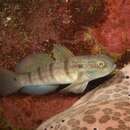Diagnostic Description
provided by Fishbase
Males with 3 black spots near base of 2nd dorsal fin and round spots on cheek; females with brown-edged band from upper lip to upper operculum (Ref. 2798).
- Recorder
- Cristina V. Garilao
Life Cycle
provided by Fishbase
Monogamous mating is observed as both obigate and social (Ref. 52884).
Morphology
provided by Fishbase
Dorsal spines (total): 7; Dorsal soft rays (total): 13 - 15; Analspines: 1; Analsoft rays: 12 - 14
- Recorder
- Cristina V. Garilao
Trophic Strategy
provided by Fishbase
Occurs in sandy areas around coral reefs and constructs burrows in the sand (Ref. 6110). Present in seagrass beds at adult stage (Ref. 41878). Feeds on microalgae and benthic invertebrates (Ref. 11889).
Biology
provided by Fishbase
Epibenthic and littoral, entering estuaries and lagoons (Ref. 4343). Usually seen in pairs, hovering a short distance above the substratum. Monogamous (Ref. 52884). t builds its burrow in sand or silty sand by moving out mouthfuls of sediment (Ref. 11441).
- Recorder
- Estelita Emily Capuli
Importance
provided by Fishbase
aquarium: commercial
- Recorder
- Estelita Emily Capuli
Description
provided by World Register of Marine Species
Also epibenthic and littoral, entering estuaries and lagoons (Ref. 4343).
Froese, R. & D. Pauly (Editors). (2023). FishBase. World Wide Web electronic publication. version (02/2023).
- license
- cc-by-4.0
- copyright
- WoRMS Editorial Board

